Menus
- Two exotic models with wheel hub steering
- From the motorcycle passion "tormented"
- Wheel hub steering – how does it even work?
- Time jump to the Bimota Tesi 1D / SR
- Manual transmission = "Box of speeds"
- How does the Majestic get its dollar exhaust?
- Bimota Tesi 3D since 2006
- Data Majestic 350
- Data Bimota Tesi 1D / SR
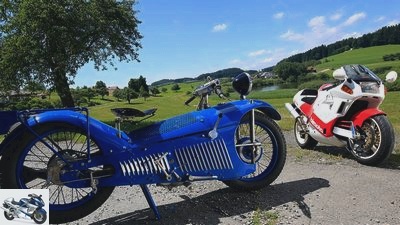

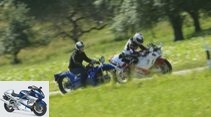
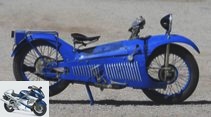
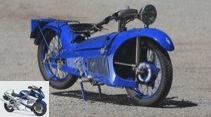
41 photos
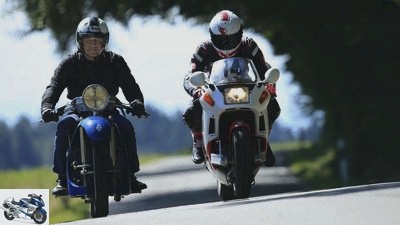
r-photography.info
1/41
Picture gallery: Majestic 350 from 1930, Bimota Tesi 1D / SR from 1992.
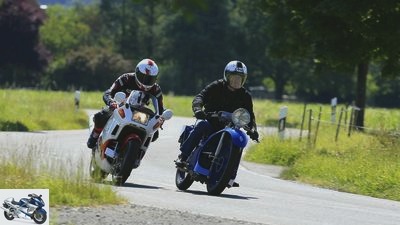
r-photography.info
2/41
The steering of both motorcycles require a certain basic speed for fast curve lines.
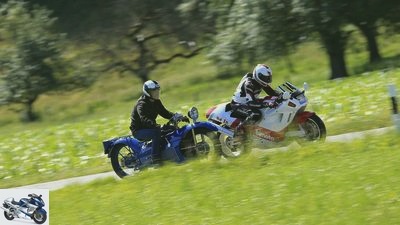
r-photography.info
3/41
Majestic 350 from 1930, Bimota Tesi 1D / SR from 1992.
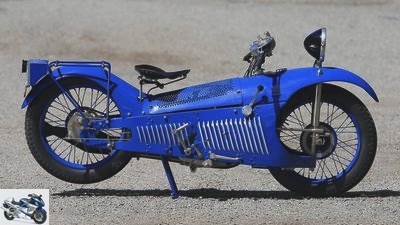
r-photography.info
4/41
In terms of art history, the Majestic with its elegant lines can be attributed to the Art Deco style.
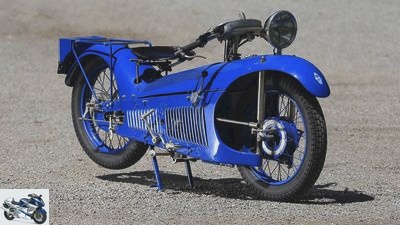
r-photography.info
5/41
Majestic 350 from 1930.
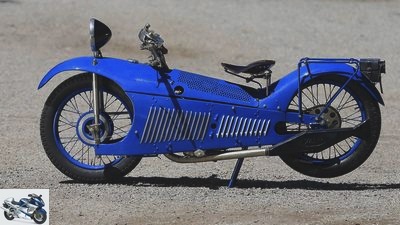
r-photography.info
6/41
Majestic 350 from 1930.
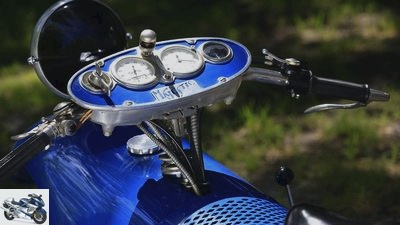
r-photography.info
7/41
The richly equipped cockpit even offers a “lighthouse” for night drives.
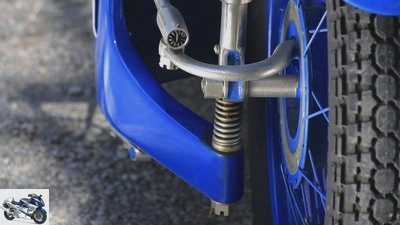
r-photography.info
8/41
The link between the handlebars and the front wheel is established via this steering lever and two deflections. There are separate springs for the compression and rebound movement.
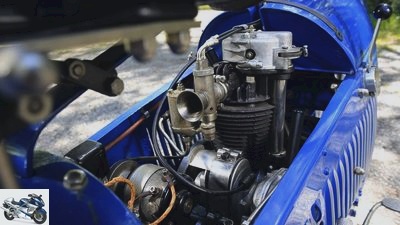
r-photography.info
9/41
Hidden in the body, but still well ventilated: 350 ohv single-cylinder from Chaise. A rather comfortable engine.
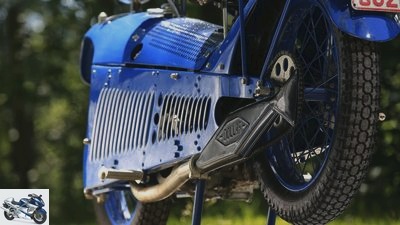
r-photography.info
10/41
The dollar exhaust may not be original, but it is consistent. Dollar producer Delachenal took over Majestic in 1929.
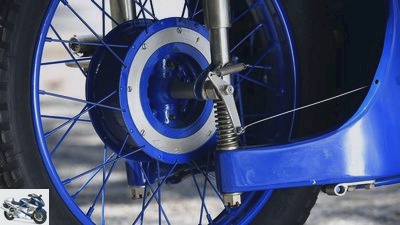
r-photography.info
11/41
Majestic 350 from 1930.
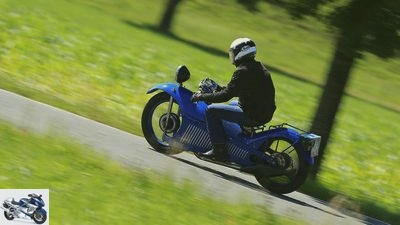
r-photography.info
12/41
Majestic 350 from 1930.
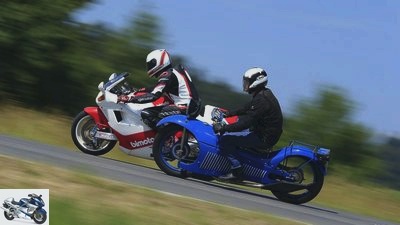
r-photography.info
13/41
Majestic 350 from 1930, Bimota Tesi 1D / SR from 1992.
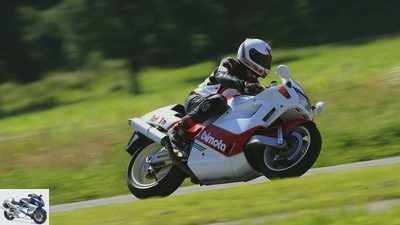
r-photography.info
14/41
Bimota Tesi 1D / SR from 1992.
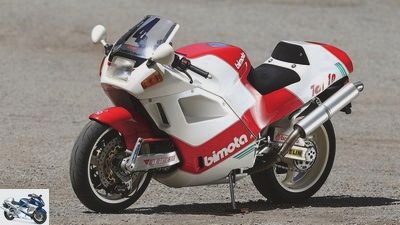
r-photography.info
15/41
At the beginning of the 90s, each test Tesi drove differently from the others. This specimen has found its center in the course of time.
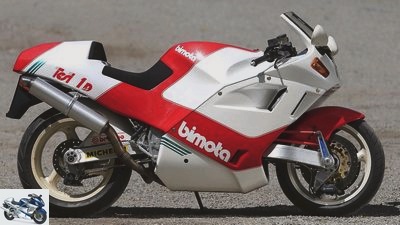
r-photography.info
16/41
Bimota Tesi 1D / SR from 1992.
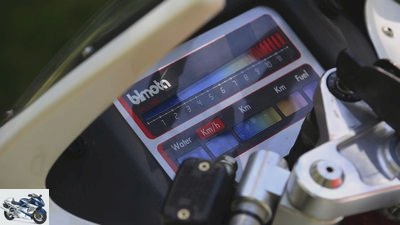
r-photography.info
17/41
With the YB4 i.e. Bimota heralded the era of LCD displays. It is logical that the futuristic Tesi also received one.
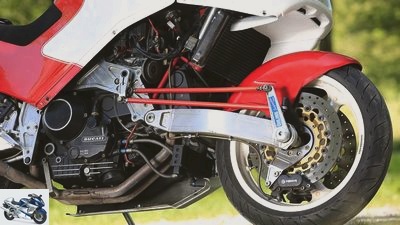
r-photography.info
18/41
Two omega profiles and the motor form the supporting structure. To change the toothed belt, the motor has to go out.
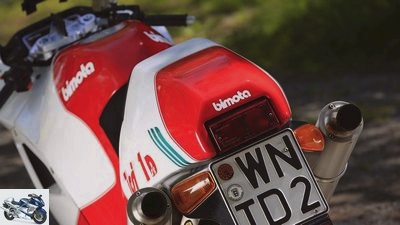
r-photography.info
19/41
Especially when viewed from the rear, the Tesi also shows beautifully curved lines.
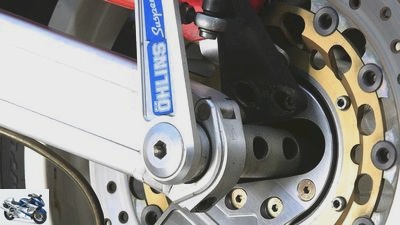
r-photography.info
20/41
It is steered via the black lever above the transverse axis of the hub cross. The levers with Ohlins stickers are used to adjust the steering head angle and caster.
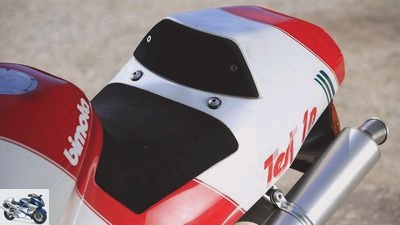
r-photography.info
21/41
Bimota Tesi 1D / SR from 1992.
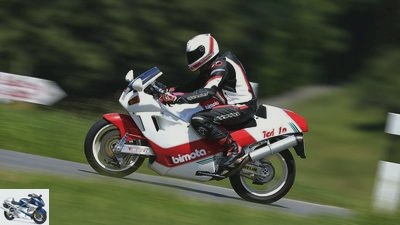
r-photography.info
22/41
Bimota Tesi 1D / SR from 1992.
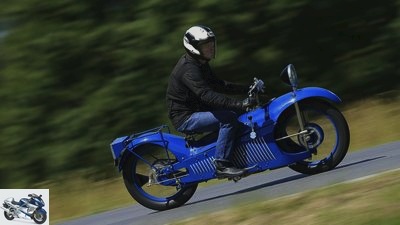
r-photography.info
23/41
Majestic 350 from 1930.
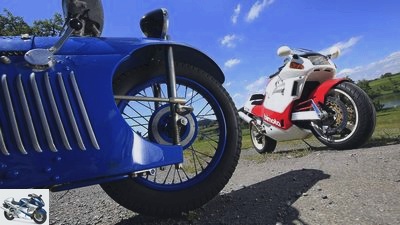
r-photography.info
24/41
Majestic 350 from 1930, Bimota Tesi 1D / SR from 1992.
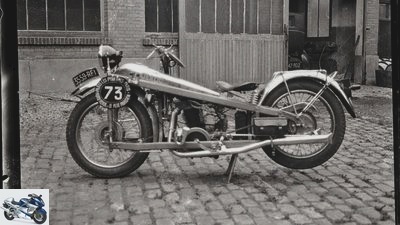
25/41
This photo has never been published before. It shows – slightly out of focus – a long-distance competition machine. The license plate indicates the Paris region.
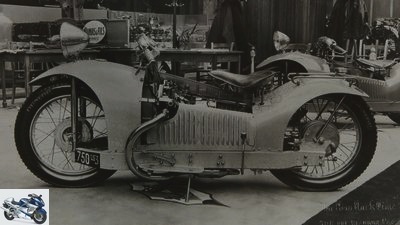
26/41
This luxury version of the Majestic carries a transversely installed 750 V2 from JAP.
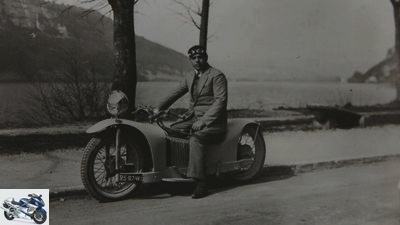
27/41
That’s how Roy drove himself: with a Cleveland four-cylinder in the new chassis.
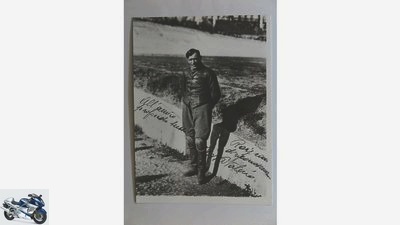
28/41
The Italian racing driver Valerio Riva (photo with dedication to Georges Roy) …
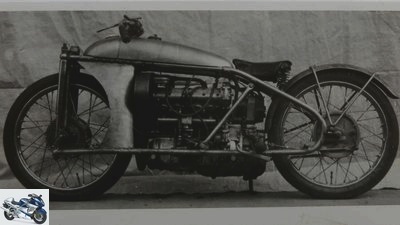
29/41
… built the Majestic front suspension into a fast four-cylinder racing machine.
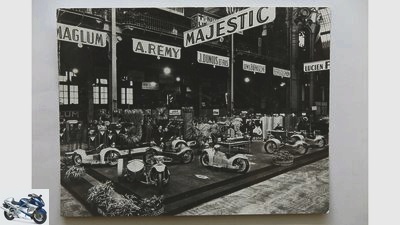
30/41
At the Majestic stand at the 1929 Paris Salon, there are still motorcycles with “side member frames”.
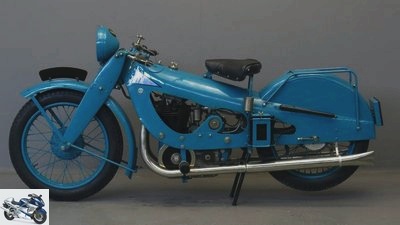
31/41
The New Motorcycle anticipated a number of the Majestic’s features in its chassis design. But not the wheel hub steering.
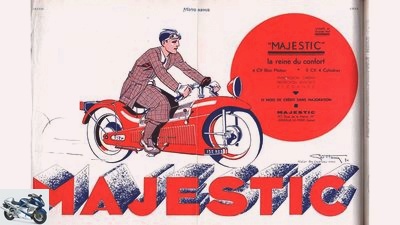
32/41
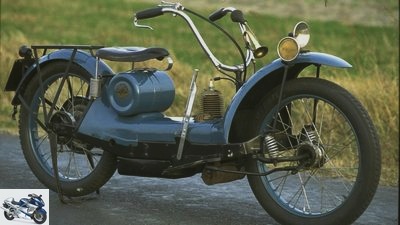
33/41
The Ner-a-Car, built from 1921 to 1926, was more similar
with later scooters than with motorcycles.
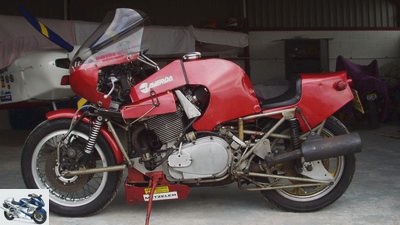
34/41
A 1000 Laverda with Difazio steering and exquisite ugliness. From 1976 it was used as an endurance racer.
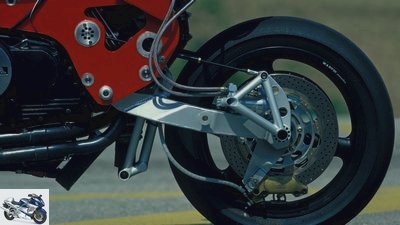
Kirn
35/41
The first Tesi: Steering was carried out hydraulically using handlebar grips that were moved up and down. The driving experience? Gruesome.
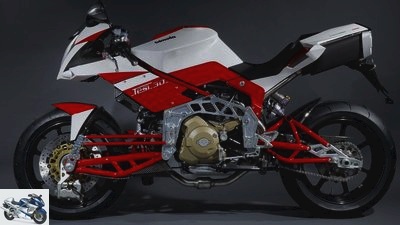
36/41
If you want to buy a bike with wheel hub steering today, you will find the pretty Tesi 3D in the Bimota range.
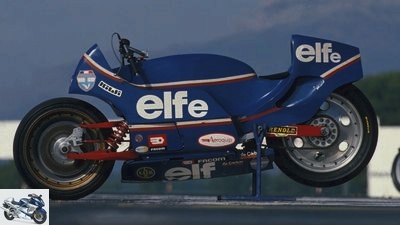
Kirn
37/41
e for x: The first eleven (left) is labeled e, but is called x. …
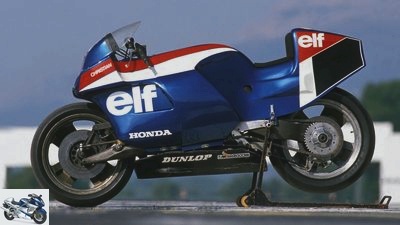
Kirn
38/41
… The actual e does not show the letter.
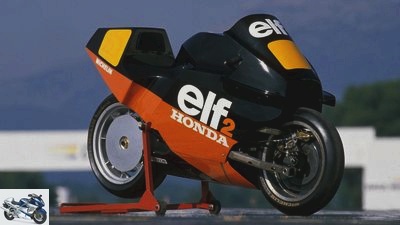
Kirn
39/41
On the first eleven 2 (left) the handlebar halves were moved up and down. …
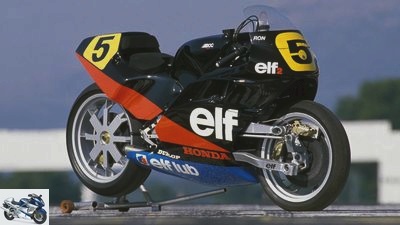
Kirn
40/41
… The second version avoided this serious error.
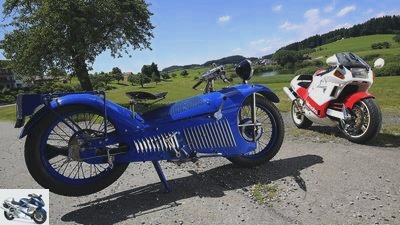
r-photography.info
41/41
Picture gallery: Majestic 350 from 1930, Bimota Tesi 1D / SR from 1992.
Majestic 350 from 1930 and Bimota Tesi 1D / SR from 1992
Two exotic models with wheel hub steering
Content of
If all the motorcycles with wheel hub steering were to be gathered, this would remain a small group meeting. They have always been exotic, complex, but fascinating constructions. MOTORRAD Classic dared to try driving a Majestic from 1930 and a Bimota Tesi from 1992.
A.At the Concorso d’Eleganza in spring this year, the Majestic 350 was one of the most elegant motorcycles. On display in the park of Villa Erba, its intense blue paintwork shone far from the row of the other exhibits, the elegant curve of its lines aroused spontaneous admiration. And whoever came closer could see that the Majestic is special not only because of its external appearance, but also because of its technology.
Buy complete article
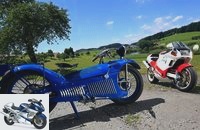
Majestic 350 from 1930 and Bimota Tesi 1D / SR from 1992
Two exotic models with wheel hub steering
Walking pace is a lanky affair
A few weeks later I got the opportunity to drive this beautiful exotic woman. Because the steering is reminiscent of the Bimota Tesi, I asked a Tesi 1D / SR from 1992 for comparison. After the Majestic 350, the Tesi 1D represents the first successful attempt to build a motorcycle with wheel hub steering in series, albeit in a small series. It has always been expensive, but it has also become a valuable classic.
r-photography.info
Majestic 350 from 1930.
When the Bimota Tesi 1D / SR was new, I was able to drive several copies as part of extensive tests, but a Majestic 350 was missing in my collection so far. So I took care of them first. With a bit of concern because the steering geometry seemed rather strange to me. The concern turned out to be unfounded. Well, when driving slowly you notice the Majestic steering that it doesn’t run as smoothly as you would expect from a well-maintained motorcycle with a conventional steering head – walking pace is a stiff affair with jerky corrections on the handlebars, as if you had complained about an excessively stiff steering damper. This phenomenon occurs from around 30 km / h; the curve lines gain in precision and elegance, they harmonize with the body of the Majestic. After a few kilometers, I trust the charming elderly lady so much that I dive with her into a long left-hand bend. In principle, the machine has no objection to this, but unfortunately it stretches its footrests too far to the side for today’s tires and roads. The historical rest grindly lost one or two grams of substance; I am warned. After all, the experience speaks for the drivability of the Majestic – you don’t turn in so quickly if you don’t feel safe.
The harmonious steering characteristics speak for the skills of the engineer Georges Roy, the designer and builder of the Majestic. Born in 1888, he experienced a phase of rapid technical development in the formative time of his youth, which was mainly driven by French motorcycle manufacturers. At the age of 19 he built a single-cylinder two-stroke engine, which he placed in a motorcycle chassis that could no longer be determined and which he also drove. Freed from the front line, he worked in an armaments factory in Châtellerault during the First World War. Most likely it was the state-owned arms factory located there, where most of the handguns for the French army were made. In any case, Georges Roy used his free time and the machine park at the site to build a scooter with a Dufaux engine. Later he worked as a lathe operator in a metal workshop. Without knowing any details about this move, I imagine it to be a disciplinary measure; because the construction of a scooter was certainly not primarily intended to promote the army’s effectiveness.
From the motorcycle passion "tormented"
After his military service, Georges Roy devoted himself to improving knitting machines and had several of his designs patented. “But the enthusiasm for the motorcycle did not let go of him”, writes the French motorcycle historian Bernard Salvat. The original reads more amusing than this translation, because Salvat uses the verb “tenailler” for “plague” or “torment”. The reader should therefore imagine Georges Roy as someone who is tormented by his passion for motorcycles.
He translated his torment into “The new Motorcycle”, which debuted in October 1925 at the Paris Salon. The chassis anticipated important design features of the Majestic, especially the straight connection between the steering head and rear wheel and the construction: large plates cut from sheet steel were pressed into shape and then riveted together. Georges Roy offered this chassis with two-stroke engines from Train or four-stroke engines from Anzani, later Chaise. It is not known how the English brand name came about. It is probably a reaction to the Anglo-American-French brotherhood in arms in World War I and an expression of a certain extravagance on the part of the designer. This is indicated by the slogan under which he presented the “New Motorcycle”: “So different from the others.”
Bernard Salvat explains the creation of the Majestic with the dissatisfaction of the designer about the handling characteristics of his new motorcycle. Like many motorcycles of that time, it had an emphatically “long” chassis geometry, which was supposed to ensure that the machine ran in a straight line on the often poor roads. Mostly at the expense of handiness. An explanation that seems plausible given the steering geometry of the new motorcycle. Georges Roy has now tried to combine driving stability with easy turning and in 1928 designed the Majestic with its wheel hub steering, in which the chassis geometry remained the same, regardless of how much the front wheel was deflected or rebounded.
Wheel hub steering – how does it even work?
r-photography.info
The link between the handlebars and the front wheel is established via this steering lever and two deflections. There are separate springs for the compression and rebound movement.
You can understand the function of a wheel hub steering more easily if you first imagine a cross-shaped structure. The wheel rotates around the transverse axis and is swiveled to the right or left around the vertical axis. This turning of the wheel to the side, however, cannot take place directly, unless one would work with twin wheels and guide the steering tube between them. Instead, it is steered via a lever which is connected to said vertical axis in the non-rotating, inner area of the wheel bearing. For this reason, wheel hub-steered motorcycles have wheel bearings with a very large outer diameter, which place the highest demands on precise machining of the seats and play-free adjustment. The steering movements are transmitted to the wheel via a rod and another lever. The lag, which is decisive for the steering properties – the amount by which the imaginary contact point of the front tire lags behind the imaginary extension of the steering axis to the ground – is caused by the fact that the designer tilts the vertical axis of the cross at a certain angle against the direction of travel. The arrangement of the handlebars says nothing about the geometry.
Did Georges Roy know of the first series-produced motorcycle with wheel hub steering, the Ner-a-Car designed in America by the German engineer Carl A. Neracher? It would be surprising if not. The Ner-a-Car was built from 1921 to 1926. He would have had enough time to get to know and understand the principle of their control.
Roy has thought through the principle of this model or maybe just its predecessor, made it more solid and enhanced it with an integrated drum brake in motorcycle-friendly dimensions. Its construction looks wonderfully clear and simple. And as strange as the suspension may appear to today’s motorcyclist – it works surprisingly well, but it also benefits from the suspension work of the front tire with its high cross-section and the elasticity of the wire-spoke wheel.
Time jump to the Bimota Tesi 1D / SR
At this point there is a leap in time of around 60 years, across all the wheel-hub-steered intermediate stages from Difazio and eleven directly to Bimota Tesi. Its name comes from the fact that the engineer and later chief technician at Bimota, Pier Luigi Marconi, submitted the construction as a doctoral thesis as the thesis that he had to explain and defend during the oral examination. In contrast to the Majestic, the Bimota Tesi 1D / SR is not only further developed in every respect, but also much more complicated. This has not only to do with technical progress, which made it necessary, for example, to integrate a double disc brake into the wheel hub steering instead of a drum. Rather, Marconi has provided numerous adjustment options for the front suspension and steering geometry, the testing of which already overwhelmed the test capacities of the small manufacturer in Rimini, but even more so did mechanics, customers and test editors.
r-photography.info
Bimota Tesi 1D / SR from 1992.
In contemporary tests, different copies of the Bimota Tesi 1D / SR drove so differently that it was almost impossible to grasp. A motorcycle with too much play in the front wheel bearings was particularly conspicuous and was commuting wildly with the handlebars on the motorway from around 140 km / h. On the positive side, it should be noted that the cause of the commuting could at least be found and eliminated. Other Tesi sparked spontaneous enthusiasm or quite a discomfort during racetrack tests, without anyone being able to say why. “You screw your fingers bloody on the Tesi. And often you get what you want by doing the opposite of what would be right on other motorcycles. It just doesn’t tell you when it is acting according to or against the theory. ”This field report comes from Dirk Linnebacher, who drove the BoT racing series on a Tesi in the early 1990s and experienced an overall sobering season despite notable successes.
That was a long time ago, and that is exactly what you can tell in a positive way about the Bimota Tesi 1D / SR in this story. After many years, its owner has apparently found the right setting for suspension, damping, steering head angle and caster. When driving slowly, the steering is a little heavier than on the Majestic because of a few additional deflections, and the steering angle is even less, but when it comes to a stop, it steers harmoniously and springs in a balanced manner. Thanks to the anti-dive effect of the front suspension, the suspension still works comfortably in wavy braking zones, despite tight coordination. The only thing that the Tesi does not achieve is the manageability of the Majestic, which is probably countered by the wide tires and the higher weight.
The performance of the drilled out Ducati 851 engine and the Brembo four-piston calipers in the front wheel is awesome anyway. Beyond all the technical subtleties of the chassis, these are the characteristics of the “modern” motorcycle that force their way into consciousness. In the interplay of acceleration and braking, the Bimota Tesi 1D / SR gains a driving dynamics that the Majestic cannot. This is mainly due to the sheer power of the engine and brakes, but the engine characteristics also play an important role. Chaise’s 350 single-cylinder that powers the Majestic feels almost like a stationary engine. Its usable speed range is narrow, and it is not rushed through when accelerating, but rather passed through with dignity. And although the manual three-speed gearbox is easier to operate than any other of this type that I have come to know, the shift breaks are naturally much longer than with foot-shifted gearboxes. The speeds that are needed to get a clean connection in higher gear are not expected to be expected of the single cylinder over a long period of time. Sure, many motorcycles from that time have that about them, but even in the 1920s there were engines that were more dynamic. The BMW R 32, for example, but above all the Brough Superior ohv 680. However, thanks to their engines, these motorcycles stood out from the crowd of other offers, not only because of their chassis.
Manual transmission = "Box of speeds"
The cozy long-stroke single cylinder explains to me how the French term for gear step could have come about: “Vitesse”, or “speed”, is what our neighbors call it. A manual transmission is a “boîte de vitesses”, a “box of speeds”. The idea behind this is that an engine always runs in a certain comfortable speed range, and the gear ratios – three in the case of the Majestic – ensure three selectable driving speeds. Today’s engines can reach between 40 and 240 km / h in one gear.
Certainly Roy knew about the at best average engine size of the 350s. Therefore, he offered the Majestic with a 500 single from Chaise and planned other alternative engines. In 1929 he sold the Majestic to Etablissements Delachenal, which had produced them on his behalf. This probably meant that different plans were superimposed. As historical photos from the Paris Salon in 1929 show, a 750 ohv V2 from JAP was also adapted. It was installed transversely and drove the rear wheel via a longitudinally installed transmission and cardan shaft. There was enough space and the hot outlet zone could be cooled relatively well.
How does the Majestic get its dollar exhaust?
For himself, Roy had built a Cleveland 1000 series four-cylinder Majestic with the older trailing arm frame. For 1930/31 the monocoque Majestic should also be equipped with a 500cc V4 from Chaise, but probably not a single machine was built with this engine. The 350s were available with chain or cardan drive. How does the Majestic get its dollar exhaust?
Delachenal produced motorcycles under the brand name Dollar, which were also powered by chaise engines. Although other Majestic specimens have a round pot with a fishtail mouth, the dollar exhaust might even be authentic. In 1931 Entreprises Delachenal went bankrupt and was taken over by Omnium Metallurgique et Industriel, the manufacturer of the chaise motors. This caesura brought the end of the Majestic. As Bernard Salvat suspects, Omnium did not want to pay royalties for its production, especially since it would have hidden the Chaise V4 behind its disguise.
Bimota Tesi 3D since 2006
Although Bimota had experienced financial turmoil several times since the early 90s, the Tesi was spared the fate of the Majestic. Although the 1D series ended in 1994 with the ES, a spark remained glowing under the ash. It even survived bankruptcy in 2000 and two changes of ownership. At first it was rekindled by the motorcycle manufacturer Vyrus. She had bought the rights to Tesi and built the Vyrus 984 C3 V2 with an air-cooled Ducati engine. In 2005, Bimota took up the concept again with the Tesi 2D, and since 2006 the Tesi 3D has been manufactured in very small quantities with tubular space arms. All successors to the 1D had air-cooled engines, so they long since put their superbike ambitions behind them. Nevertheless: In the history of wheel hub steering, which has always been threatened with extinction, the Tesi is almost a guarantee of continuity.
Data Majestic 350
r-photography.info
In terms of art history, the Majestic with its elegant lines can be attributed to the Art Deco style.
Engine: Single-cylinder four-stroke engine, a gear-driven, lower camshaft, two valves operated by push rods and rocker arms, bore x stroke 75 x 79 mm, displacement 349 cm³, power about 11 hp at 3,700 rpm
Power transmission: Multi-disc oil bath clutch, three-speed gearbox, chain drive
Landing gear: Monocoque made of riveted press plates, rigid rear wheel guide, front suspension with two spring struts, wire-spoke wheels with steel rims, front and rear tires 4.00-19, front duplex drum brake, rear half-hub simplex drum brake, saddle with sprung struts
Weight: about 150 kg
Mileage: Top speed around 90 km / h
Data Bimota Tesi 1D / SR
r-photography.info
Bimota Tesi 1D / SR from 1992.
Engine: Transversely installed 90-degree four-stroke V, two overhead camshafts driven by toothed belts, four desmodromic actuated valves per combustion chamber, bore x stroke 94 x 68 mm, displacement 904 cm³, compression 11.6: 1, output 113 hp at 8,500 / min
Power transmission: Multi-disc dry clutch, six-speed gearbox, chain drive
Landing gear: Frame profiles made of light metal, load-bearing engine, pushed two-arm swing arm with lever system and spring strut at the front, two-arm swing arm with lever system and spring strut at the rear, cast light-alloy wheels, front and rear tires 120/70 ZR 17/180/55 ZR 17, double disc brake at the front, disc brake at the rear, Ø 320 / 230 mm
Mass and weight: Wheelbase 1410 mm, weight with a full tank 213 kg, tank capacity 16 l
Mileage: Top speed 235 km / h
Price (1992): 59,200 marks
Related articles
-
Gori driving report Bimota Tesi 3D Tesi is alive For a good 20 years, the high-class forge from Rimini has been trying its hand at motorcycles without a telescopic fork. Can the new Tesi …
-
Technology highlights: Bimota Tesi, Honda NR 750, Norton TT
Jahn Technology highlights: Bimota Tesi, Honda NR 750, Norton TT Techno motorcycle The pace of further development in two-wheelers is getting faster and…
-
Jahn driving report Bimota Tesi 2D Tecnologia dell´Emozione Two years ago the small Italian company VDM, like Bimota in Rimini, introduced the …
-
Bimota Tesi 3D Biposto-Mono in the driving report
Cathcart 14 pictures Cathcart 1/14 Bimota importer Benny Wilbers: A Bimota Tesi, that’s art on wheels. Cathcart 2/14 The feedback from …
-
On the move: Benelli 750 Sei, Honda CBX 1000, Kawasaki Z 1300
Bilski 17th photos Bilski 1/17 Who is the widest in the whole country? The angle of spread of the driver’s legs provide information. Bilski 2/17 With…
-
Impression Bimota SB 3 The Bimota by Klaus P. A Bimota from the very beginning is not a motorcycle, it is an event. Such a sparkling synthesis of …
-
Short test Bimota SB 6 R Bella Bestia In the pilot series, the devil was in the details. Importer Konemann promised a remedy. Does the beautiful predator work …
-
Driving report Bimota SB 6 R Draft horse Often promised – never kept. Only the SB 6 R has what the SB 6 was previously lacking: power and performance. The thing …
-
Jahn driving report Bimota DB7 lightning fast precious genius and madness ?? Bimotas, which were made before 2000, carried both in about equal parts …
-
On the move with the BMW R 69 S.
Gargolov 30th photos Gargolov 1/30 Gargolov 2/30 Gargolov 3/30 Gargolov 4/30 Gargolov 5/30 Gargolov 6/30 Gargolov 7/30 Gargolov 8/30 Gargolov 9/30…